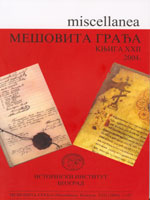Израчунавање Петровог месопуста, поклада и поста према рукопису АСАНУ No 24
Calculations of St. Peter's Meat-Fare Day (Petrov Mesopust, Petrove Poklade and Mesopust Petrovog Posta) and the Lenght of St. Peter's Lent
Author(s): Stanoje BojaninSubject(s): History
Published by: Istorijski institut, Beograd
Keywords: St. Peter’s Day; St. Peter’s Meat-Fare Day (eve of the Apostles’ Fast); The Apostles’ Fast; Paschalia; movable feasts; reckoning time according to feasts; popular and oral culture
Summary/Abstract: Three short texts from the XVth century manuscript (Archives of Serbian Academy of Arts and Sciences No. 24), written as comments of the paschal tables, were published in this work. They contain instructions for calculating St. Peter’s Meat-Fare Day, i.e. the eve of the Apostles’ Fast (Petrov mesopust, Petrove poklade and Mesopust Petrovog posta) and the lenght of the Holy Apostoles’ Fast. The strong influence of the vernacular is observable and recognizable even in the mere names of the aforementioned feasts. Those texts may not be classified as usual comments and “learned” instructions concerning the paschal tables, like those, for example, used for the calculation of the cycle of epact, of the lunar and solar cycles, golden number and others. They represent an important testimony on the elementary time calculation patterns in the popular and oral culture: days were reckoned either by counting to or counting off, or by putting an emphasis on mutual connection between certain feast days of the first half of the year preceding or following the Easter. Having knowledge of these connections represented the fact of straightforward practical importance since it was aimed at facilitating orientation on the Ecclesiastical Feasts Calendar in the society which considered literacy to be a non-obligatory issue, but obeying the feasting and fasting periods a compulsory one. The published data gain particularly in importance when they are compared to the almost identical time reckoning practice that existed in the folklore of the XIXth and of the beginning of the XXth centuries.
Journal: Мешовита грађа
- Issue Year: 2009
- Issue No: 30
- Page Range: 7-14
- Page Count: 8
- Language: Serbian

